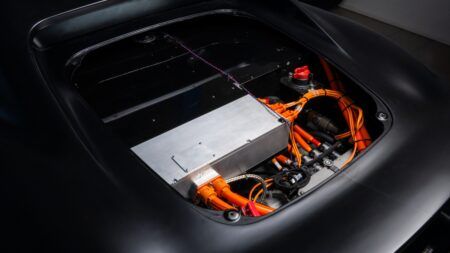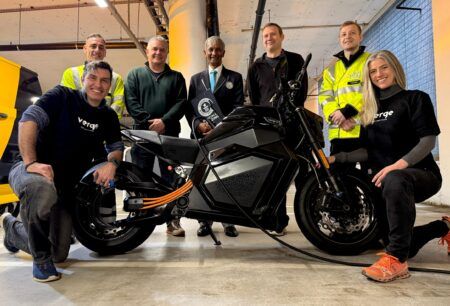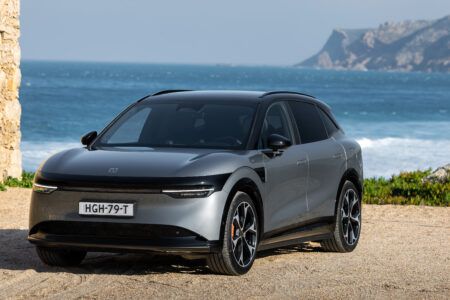The era of electrification has given the industry many design, engineering, and technological breakthroughs in addition to the primary point of positive impact – the high-tech, silent-running, zero-emissions powertrain. Obvious additional developments to reference that have been enhanced as the passenger car transitions from an internal combustion engine (ICE) application into an electric vehicle (EV) includes the need for a different type of architecture, chassis, suspension, ergonomics, aerodynamics, acoustics, aesthetics and even multimedia functionality. Yet one area that is far lesser discussed – if at all, in fact – is steering.
“In every respect, an EV behaves differently to an ICE vehicle,” says George Lendrum, Titan CEO, “So it stands to reason the steering setup for passenger cars powered by electric motors and a battery pack needs to be re-evaluated. Steering solutions should be tailored to meet the specific needs of the electric mobility era.”
The way a car interacts with the driver – executing commands and heightening emotions through all the senses – is channelled primarily through the steering arrangement. “That small ‘window’ is where the connection between man and machine, driver and car, is made,” Lendrum says. “Now, granted that’s a quality that might in the longer term radically change as the industry potentially heads to fully autonomous driving, but it certainly won’t play any lesser role as we switch from internal combustion to electric powertrains, be that in hybrid form, full battery electrification or the hydrogen fuel cell.”
 Driverless delivery to electric hypercars
Driverless delivery to electric hypercars
Lendrum is well placed to understand the intricacies of steering technologies for the automotive industry. With a career spanning 37 years, he has been at the helm of Titan since 2014. It’s safe to say that Titan is something of a hidden engineering gem, its modest company culture – “we don’t like to shout too loudly” – masks the innovation that the organisation has consistently delivered in its four decades of existence, stemming from motorsports and then into automotive. Not only is Titan considered one of the pioneers in steering technology (for those that happen to already be in the know), but it also offers a wide application spectrum – from autonomous last-mile delivery vehicles through to electric hypercars and everything in between, harnessing its rich heritage and experience stemming back to the 1960s when it was developing pioneering racing cars.
Thanks to the organisation’s expertise in high-tech precision engineering, the breadth and depth of Titan’s steering portfolio today encompasses advanced mechanical, hydraulic, electric and steer-by-wire solutions. For the latter, the company has just launched its all-new state-of-the-art steer-by-wire system for which Titan’s engineering team has developed a completely bespoke electric motor that it manufactures in-house alongside the entire steering system at its high-tech HQ in Cambridgeshire, UK. The steer-by-wire innovation also features an in-house developed (and manufactured) bespoke electronic control system that is slated to 48-volts. Lendrum says the package, “enables optimum performance and, just as importantly when it comes to steering arrangement, infinite tuneability.”
Paul Wilkinson, Titan’s technical director, says the launch of the company’s by-wire technology has been perfectly timed: “As we transition from ICE to EV, one of the challenges in the steering space of the wider automotive industry is the numerous ‘off-the-shelf’ offerings available to OEMs. These solutions do a job, but they tend to be lacking in the precise engineering and technical qualities that an electric vehicle requires from its steering arrangement.”
 To counter this, a few years ago Titan embarked upon a strategic roadmap to ensure the business was ready for the ‘new’ electric powertrain era. With a team of over 90 specialist engineers, Titan today offers the industry tailored and highly tuneable steering systems to enable its customers – on the whole smaller and more focused volume manufacturers producing varying mobility applications in many different sectors, from modular and practical commercial vehicles through to high-end high-performance hypercars – to rapidly initiate the development of physical prototypes of their EVs. Lendrum says this key advantage empowers OEMs to take the first step to full production, where Titan can provide further support with the manufacture of complete steering systems with production runs from 50 to 5,000 units per year.
To counter this, a few years ago Titan embarked upon a strategic roadmap to ensure the business was ready for the ‘new’ electric powertrain era. With a team of over 90 specialist engineers, Titan today offers the industry tailored and highly tuneable steering systems to enable its customers – on the whole smaller and more focused volume manufacturers producing varying mobility applications in many different sectors, from modular and practical commercial vehicles through to high-end high-performance hypercars – to rapidly initiate the development of physical prototypes of their EVs. Lendrum says this key advantage empowers OEMs to take the first step to full production, where Titan can provide further support with the manufacture of complete steering systems with production runs from 50 to 5,000 units per year.
“Despite the evolution of steering systems throughout the ages – mechanical, hydraulic, electric power and now by-wire, I still sense that many within the global automotive industry consider mechanical steering to be the ‘holy grail’ of steering systems, especially in terms of delivering the ultimate driver experience,” says Lendrum. “Hydraulic systems are considered the next best option due to the similarity in characteristics to their mechanical cousins. From there, I feel the industry views electric steering systems as a technology that has yet to reach full potential in terms of optimum performance and steering feel compared to the more mature technologies.
“But one of our core engineering objectives – which means we must continuously push technical boundaries – is to develop electric steering systems that can truly emulate the authentic feel of a mechanical design. This is especially pertinent for the new generation of EVs, which often are unfairly branded by some observers as dull, un-engaging and lacking in dynamism. In fact, the opposite to this viewpoint couldn’t be truer and especially when you consider that Titan’s goal is to get to a place where drivers will not be able to discern the difference between the two competing steering systems.
“These ultra-advanced electric and by-wire systems that we are working hard to develop, further advance and optimise, will ensure drivers can enjoy a direct and responsive steering feel and connection with their EV.”
 Steering alchemy
Steering alchemy
Lendrum says that, on average, it takes Titan between 15 months and two years to develop a full, safety-critical, production-ready advanced steering system. “Unlike larger suppliers offering systems with limited levels of tunability,” says Wilkinson, “We provide systems where customers can alter the steering kinematics – essentially the steering ratio and geometry. This approach literally gives customers the freedom to not just set up the steering as they wish for their EV but also the suspension geometry. By doing so, steering feel and response is not only enhanced, the broader ride and handling package is improved, in addition to NVH and overall vehicle refinement, added characteristics that are key for vehicles that run on silent electric powertrains.”
In this respect, Titan leads the way in offering practises that ensure the optimization of steering elements, including the speed of the steering system, steering ratio, pump pressure, valve pack and torsion bar characteristics, all of which profoundly impact steering feel, immediacy, and consistency of response.
Located at St Neots, adjacent to Cambridge, Titan’s impressive two-building site includes a steering technology demonstration suite and a comprehensive manufacturing facility with 25 CNC machining centres, including five-axis milling machines. The company deploys the latest in virtual development and tool design, including Finite Element Analysis, Computational Fluid Dynamics and Design for Manufacture to assist with the ease of build and repeatability of assembly.
Lendrum sums-up Titan’s USP: “Our flexibility, modularity, on-going investment into high-tech machines and in-house expertise – but it’s the talented people that make Titan what it is today. And we occupy a unique position in the marketplace compared to the traditional Tier 1 suppliers. As the industry adopts electrification into the mainstream, true engineering-led companies – such as ours – have nothing to fear. Where some see challenges, we only see opportunities.”





